
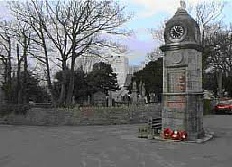
Cymdeithas Hanes Mechell

The Demography of Llanfechell 1851 & 1901
William Bulkeley and the poor of Llanfechell
Llanfechell in the early 19th Century
with thanks to the Reverend Canon Geraint W. Edwards
|
The History of the Church from the Diaries of William Bulkeley |
The church is dedicated to St Mechell, or Mechyll ab Echwys Gwyn gohoyw meibion Gloyw Gwlad Lydan. A cywydd (the name given to a Welsh poem in a special metre) was written in his praise called Cywydd i Fechell Sant by an anonymous bard and it is to be found in Llawysgrif Llansteffan 125, from the middle of the 18th century. His feast day falls on 15th November.
Windows donated by the Brynddu family.
In memory of The Reverend William Hughes, Rector and his son.
*********************************************************************
*********************************************************************
Click on photographs to see larger versions
There are two traditions to why this was built. According to the first the Chapel House across the road used to be a brewery and the ringing of the bell was said to cause the beer to go sour. According to the second, we are told that Colonel Hughes Hunter of Brynddu complained that the tolling of the bell disturbed his bees and stopped them making honey. It is suggested, therefore, that it was built to tone down the sound of the bell in the village!
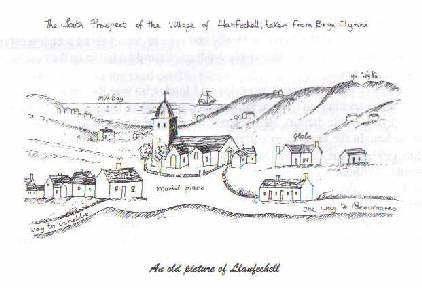
There is, however, an old drawing that suggests that the dome is much older than this and may well have been there at the time of William Bulkeley.
***************************************************************************
A history of the Church from the diaries of William Bulkekey
We are extremely indebted to the late William Bulkeley of Brynddu for much of the history of the church during the 18th century. Bulkeley was born on 4 November 1691 and baptised the following day at Llanfechell Church.
He was married to Jane, the daughter of the Reverend Ambrose Lewis, third son of William Lewis of Cemlyn on 22 May 1710. They had two children, a daughter Mary and a son, who studied law and died at a comparatively early age.
William Bulkeley is referred to in the Bywgraffiadur Cymreig as a diarist and a squire. There are two diaries to be had, one dating from 30 March 1734 to 8 June 1743 and the other from 1 August 1747 to 28 September 1760. They are full of information about Anglesey, especially the region of Talybolion, family matters, social customs and church administration.
Bulkeley thought a great deal of the parish church at Llanfechell and its welfare
was always close to his heart. He referred to it constantly in his diaries. Although
he himself was never appointed a churchwarden, he had no hesitation in taking upon
himself much of the responsibility of that office as Nesta Evans tells us in her
book ‘Religion and Politics in Mid-
William Bulkeley writes of his parish church with the authority of a squire who lived all his life in Llanfechell, went to church regularly every Sunday, was on terms of friendship with his rector and, in short, knew all there was to know about everyone who lived in the parish. He was not himself a churchwarden, but he had no hesitation In taking it upon himself many of the duties of a churchwarden
Bulkeley and his contemporaries inherited a church that had much love bestowed upon it. It had been the subject of a great deal of building and improvements over the years.
Nesta Evans testifies in her book that; the stones of the church themselves speak of the care and affection bestowed upon it.
Llanfechell parish in Bulkeley’s time, was divided into two townships, viz, Llawr y Llan and Caerdegog. He was one of the people of Llawr y Llan. We have an interesting example, in one of his diaries, of how Bulkeley would lobby the people of Llawr y Llan to oppose the people of Caerdegog in order very often to get his own way!
This day a Vestry was held in Llanfechell church (sumoned by the parson at the request of the churchwardens the first day of this month) to consider what tax was sufficient to make up the Mood over the Chancell etc. which had been warmly opposed in words some days before by Caerdegog people particularly Wm Hughes of Wylfa, Watkin ab Wm. Watkin and Humphrey Mostyn, and had to that end appeared there all to a man, there being, (I believe) not above 3 of that Township wanting which did not come there with the intent of opposing the makeing of the Mood, but I haveing notice of their design secured all I could in Llawr y Llan Township who all appeared there in such a Number that they did not think fit to open their mouths, or make any opposition at all, so it was agreed to make a new Mood, and 4d in the pound was voted for that purpose, and the other necessary uses of the Church (10 Jan 1735).
The church that Bulkeley and his contemporaries would remember was quite different from the one we know today. There was no seating, for example, as we see in it today, but there must have been some sort of benches. Not until 1700 did pews become general in town churches. Swift in 1725 lists a church without pews among the plagues of country life. Evidently there were benches in llanfechell church during Bulkeley’s day as his diary records on 4 June 1738:
A very great congregation at Llanvechell Church: having last week set up benches on ye right of Pen and Tyddyn Weyn, I ordered ye tenants of ye same to sit thereon, and turned out Hester Bulkeley & her daughters from hence.
A week later he wrote:
Set up benches in their place this morning that J. Bulkeley Bwchanan & Hugh Wm Pugh had removed when I was from home, & my people sat on them & Ester B, and her Daughter removed them again after service, & I had them again replaced.
Dr Thomas Richards tells us that the diarist had need to be careful in this matter, because John Bulkeley of Bwchanan was the Baron Hill chief agent, and married to Bridget, sister to two successive Viscounts.It was common, in the 18th century, for disputes to arise over seats in churches, some of them going as far as law suits
The walls and roof of Llanfechell church, like many of the churches in Bulkeley’s
time, had been whitewashed. It is not generally supposed that this was for hygiene,
but that the whitewash was intended to cover any pre-
Rushes were used to cover the floor of the church and it had to be changed occasionally. In May 1739 Bulkeley records:
This day in the vestry held in the church it was proposed that John Jones of haven y Micht & Owen David of Minffordd….. should annually provide Marsh Rushes and Morasc to be laid on the floor of the chancel 6 time in the year, in the severall seats and benches therein & on the windows& also in the seats in the body of the church, & in all the windows within such seats, and that Hugh Owen of Nant Yr Eirin Cooper, and Nan of Tynywern should yearly six times in the year sweep and make clean the rest of the body of the church and provide the comon green Rushes to lay on the floor of the same thorout, and every time it is so swept; & the sd. John Jones, Owen David & Hugh Owen (Nan Tynywern being not there) being publickly called upon & asked if they did severally agree to the said proposal they…. agreed …. In the presence of such parishioners as were then present.
Mary, William Bulkeley’s daughter, was married to Fortunatus Wright a brewer and distiller who came from Liverpool. Wright became one of the most successful privateers of his time. He usually just managed to keep on the right side of the law but when he was in Italy, where he was based for some time, the Tuscan authorities clapped him into prison for some doubtful activities relating to the seizing of foreign ships. It must be said of him that he was a typical swashbuckling eighteenth century adventurer, looked upon as a hero by the British, feared by the French, and a very brave man. He was, after a highly adventurous career, presumed lost at sea.
The Bywgraffiadur Cymreig describes the marriage as a great tribulation in life and a disappointment to Bulkeley.
A son from the marriage was buried within the walls of Llanfechell Church.
Nesta Evans in her book maintains that this is a late example of an inter-
Today was landed in Cemaes the corps of my Grandson who died in Leghorn and was sent from thence to Dublin, & brought from Dublin to Holyhead in the Paquet Boat & from Holyhead to Cemaes in a trading Vessell that came for corn; it was the request of his mother to have him brought hither to be buryed among her Ancestors; accordingly he was sent for this day & carryed to Llanvechell and buryed in the lower part of my seat in ye chancell close by the wall, I gave Anna Wright his sister 10s 6d to give to the priest & 2s 6d to give to the Sexton & gave the Master of ye Vessell 10s 6d for carrying it from Holyhead to Cemaes. (20 December 1756).
The late Helen Ramage believed that the grave was under the present lectern
Congregations were far more numerous during Bulkeley’s day:
The morning service began at 9 o’clock and was over a quarter before 12, about 170 communicants this day, and I do remember severall Easter Days within 20 years last past where on Easter Day the number of Communicants some Easter days onely (besides ye communicants on Easter Eve) were 260, sometimes 240, but never less than 220 till within this 7 or 8 years, since which, a great mortality destroyed almost half the parish.
Religious life in a village, in the mid eighteenth century, depended very much on
the character of the parson. According to J Graham Jones in his book on the history
of Wales; many of the clerics were poor and uneducated. In many instances the country
squires were receiving the tithe money instead of the parish clergy. This being so
the wages of the clergy were poor and many had to have more than one living in order
to survive. The assistant curates were even worse off and their standard of living
could only be compared to that of their poorest parishioners. Very few clergy had
had University training. The Bishops held sees in Wales only as a stepping stone
to much more lucrative sees in England. The church remained to all intents and purposes
a medieval institution without either the means or the will to reform itself. Not
a single bishop was appointed to a Welsh see between 1713-
It would seem that Llanfechell had a reasonably good Rector compared to many parishes. His name was Richard Bulkeley and he was a distant relation to the diarist. both descending from the younger branches of the Bulkeleys of ‘Baron Hill’ in the parish of Beaumaris.
Richard who was inducted Rector on 8 January 1738 was the parish priest throughout the years of the diaries except for three. The following words were recorded in the church register when he died on 13 March 1757:
Paid Mr Richard Bulkeley, the parson of Llanvechell 13s 4d for a sermon preached on St Barnabas Day in ye year 1738.
One thing that would annoy William Bulkeley was the practice, in those days, of starting a sermon one week and finishing it another:
A piece of a sermon yt lasted 17 minutes, & promised to finish it some other time. Thus, poor laymen must we be used till God pleaseth to put in the heart of our Legislators to reform ye behaviour of our Clergy. (27 Mehefin 1738).
On 17 September in the same year he has this to say:
Onely a piece of sermon 14 minutes long, he promised the other piece a fortnight hence, thus it has been always used by this man to make one sermon serve for a month.
Also:
The priest finished his third and last part of his sermon on hell fire began this day six weeks.
Here again is another rather scathing criticism of Richard’s preaching::
It is remarkable of this priest that he always preaches upon sin in generall, denounces terrible Judgments against Sinners. Yet I never remember to have heard him mention in any of his inspired Sermons what those Sins are which God is displeased with the committing of them… as he manages matters, I daresay few are either the wiser, or go from church with any impression wrought on their minds. (28 Chwefror 1748)
During the eighteenth century, baptisms, weddings and funerals were part of the normal Sunday worship:
A great congregation at Llanvechell Church and a long service, there being 2 burials, a Christening and a woman churched (1738).
This is what Bulkeley had to say about a wedding he attended:
2 of my servants were marryed today, Robert Pritchard and Jane Hughes to whose wedding I went with my Daughter and Cousin Henry Hughes. Mr Roger Mostyn of Colcott comeing to see me, was forced to take him along likewise it cost me 3s 6d because I treated him, in ye evening coch Carrog came there so that the company was forced to break up an hour or 2 sooner he being Drunk and unruly, we pd. 1s a piece for our dinner and 6d for ale ( 9 Mehefin 1734).
There is little doubt that much more could be written about William Bulkeley but one must conclude by saying that he was a mischievous man who loved to provoke people. On the other hand there was not a squire on Anglesey who was more of a Welshman than he according to the Bywgraffiadur Cymreig.
Bulkeley was buried on 28 October 1760.
References
G. Nesta Evans. Religion & Politics in Mid-
Y Bywgraffiadur Cymreig hyd 1940.
*********************************************************
The following extract was found in the Rectory from a report by T. H. M. Tildesley to the Anglesey Antiquarian Society in 1912:
There is a stone built church with a single aisle terminating in a belfry surmounted by a curious cupola the only one of its kind on the island. On either side of the church are two small transepts, which, had they been continued up to the roof would have made the church of a cruciform shape. The first noticeable feature is the porch which is paved with antique tombstones, one of which is dated 1664. The roof of the porch is carved by ancient oak beams.
In an upright position in one corner is a weather beaten sepulchral slab which has always been within the church within memory. There is also an old wooden bier in the porch, which is still used for funerals. It is of oak and on it is carved the date 1601. Inside the church, opposite the door, stands the font, which is of carved stone and square in shape. It is made in two pieces, the upper of which is 4 inches less than the lower. The lid is of very ancient oak and is raised by two wooden handles running from corner to corner and crossing one another midway. Several of the windows are filled with stained glass. The east window (given by the Plas Coch family) being the finest of these, whilst two others are in memory of the late Reverend H. Hughes, M.A. (Rector of the parish) and Mr Bulkeley Hughes M.P. All these windows are deeply embrasured in the walls, which are of great thickness. The roof and its supporting beams are modern, the former thatched roof having being replaced, so I was informed, about 100 years ago.In the belfry there is a single bell, which is reached by a winding flight of stairs inside, while the basement of the tower is used as a vestry. The chamber is walled and floored with tombstones some of which date as far back as 1678. On the south side of the church there has been recently opened a small doorway, which had been for years previously been closed up and which is surmounted by a semicircular archway of apparently very ancient construction. On the same wall there is a mural tablet of the Meyricks of Cefn Coch. In the church there is a card displayed stating that the reputed date of the foundation of this church is 630 A.D. and that it was reconstructed in 1533 but of this there is no confirmation.
*********************************************************************
The font : square gritstone bowl each side with a sink panel containing two round arches, with square imposts on all but the north side. It has been cut away at the base and stands on a stoneplinth made up of window mullions. 12th century.
The chalice : This old chalice which is occasionally used is the work of Hanz Zeiher
of Nuremberg and dates back to the 16th century. The bowl is oval with a fluted surbase
and is ornamented with strap-
*********************************************************************
The windows
The stained glass windows are nearly all donated by the Brynddu family, except two,
one in memory of The Reverend William Hughes, Rector from 1880-
The leper window
A window from the fifteenth century
A stone with a crudely carved human face above the south transept is medieval.
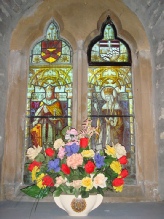
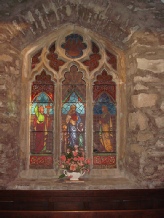
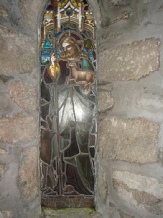
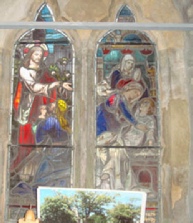
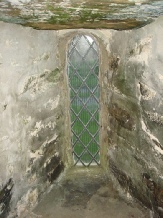
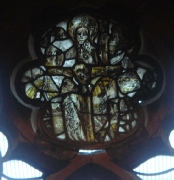
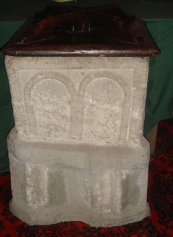
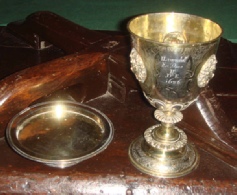
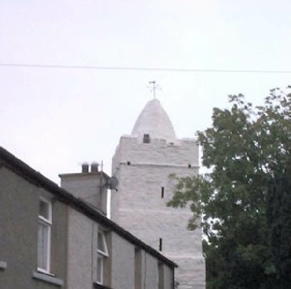
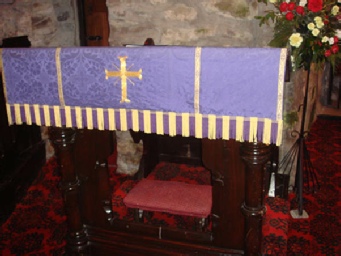
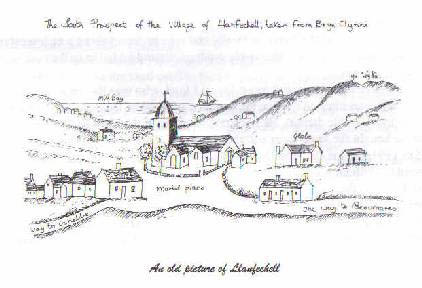
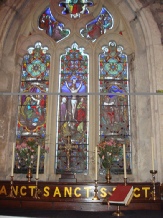
The Church
The parish church of Llanfechell stands on the east part of the parish. The nave and the west part of the cancel are probably of the 12th century. The chancel was lengthened in the 13th century and the south transept was added in the 14th century. The north transept is modernized and of uncertain date. The west tower was built in the 16th century. The south port is modernized but is probably medieval. It is possible that the 12th century church had a central tower, as suggested by irregularities and straight joints in the walls near the crossing.